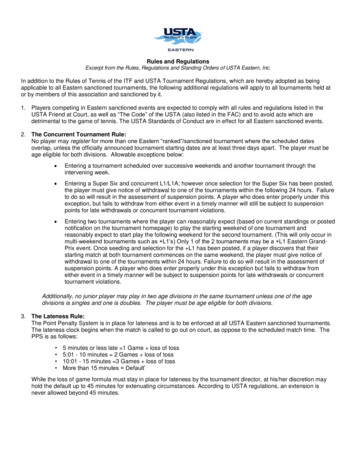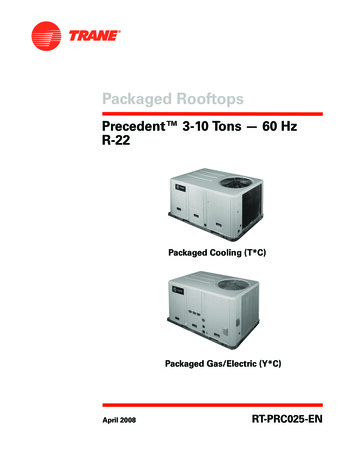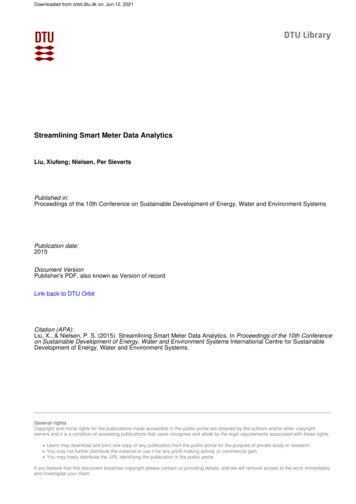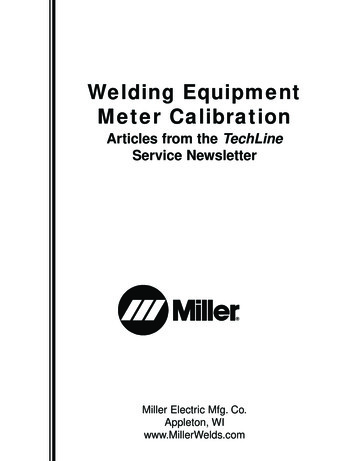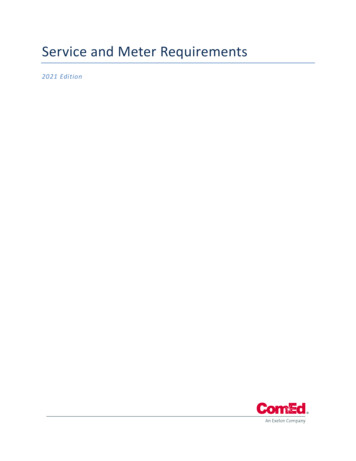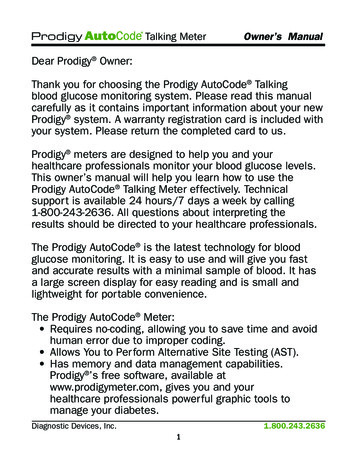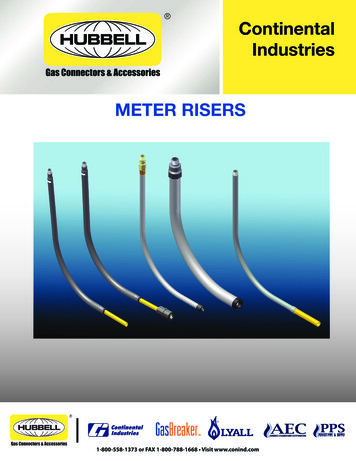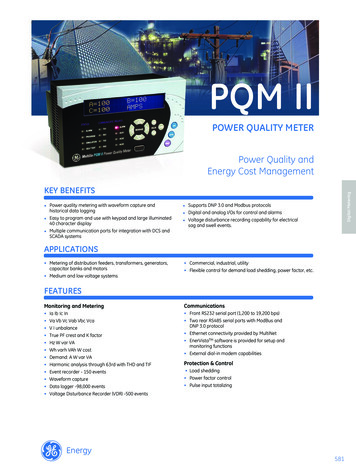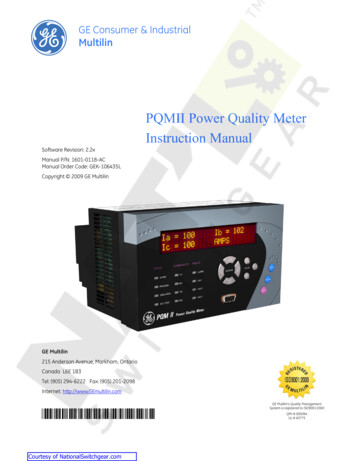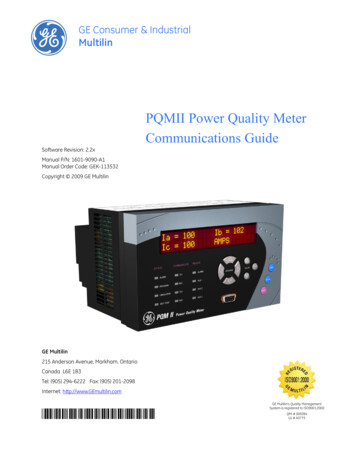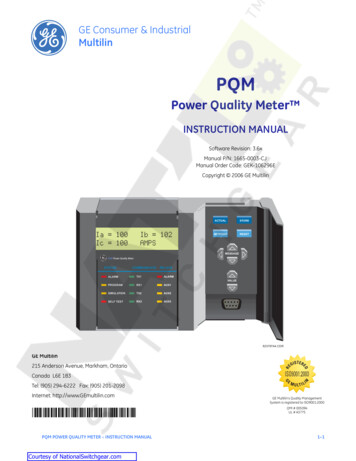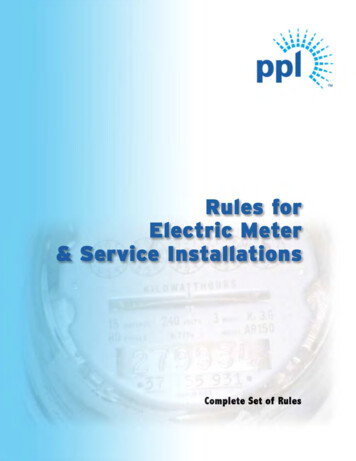
Transcription
RULES FOR ELECTRIC METER& SERVICE INSTALLATIONSLIST OF RULES - INDEXRule 1updated 03-18-2013Rule 2updated 07-09-2015Rule 3updated 06-26-2013General(a) PPL EU's Standard Service(b) Overhead System(c) Underground System(d) Meter Sequence (Hot/Cold)(e) Single Point of Service(f) PPL EU Specifies Service Characteristics, Method ofService/Supply and Point of Service(g) Notify PPL EU of Load Growth(h) Separate Point of Service(i) Separate Point of Service – Fire Pumps(j) Alternate Service(k) PPL EU Makes All Connections(l) Alteration of Interference with PPL EU's Property(m) Placement of Swimming Pools, Fountains and SimilarInstallations(n) Hazardous Locations(0) Electrical Equipment CoversService Available At Secondary Voltage(a) Standard Service Voltages(b) Non-Standard Service Voltages(c) Residential Service(d) Combine Three Phase and Single Phase Loads(e) Metering Equipment Not Used as Junction and/or Pull Box(f) Service Termination Compartment Not Used as Pull Box or toConnect Customer EquipmentNOTES:1. 2 Wire Service Limited2. Residential Service at 120/208 Volts3. Single Phase, 3 Wire Service4. Three Phase, 4 Wire, 240 Volt, Delta Service5. Three Phase, 3 Wire, 480 Volt, Delta Service6. Three Phase, 4 Wire, 480Y Volt Service7. Single Phase, 3 Wire 240/480 Volt ServiceService Available At High Voltage(a) Service at Line Voltage(b) Service at Other Than Line Voltage(c) Standard Service Voltages(d) Transformer Connections, Voltage and Tap Specifications(e) Single Phase High Voltage Service
Rule 4dated 08-10-2006Secondary Service - Service Drop and Point of AttachmentInformation(a) Method of Service(b) PPL EU Designates Point of Attachment(c) Point of Attachment(d) Maximum Length of Service Drop(e) Service Attachment(f) Attachment for Low Buildings(g) Attachment to Customer-Owned Service PoleRule 4Adated 06-02-2006Rule 4Bdated 06-02-2006Rule 5updated 12-11-2018Secondary Service - Clearance Information(a) Clearances Over Areas and Buildings(b) Clearances Under Communication Company Lines(c) Clearances Between Gas Facilities and Electric Meters(d) Clearances Between Satellite Dish and PPL EU FacilitiesSecondary Service - Relocation and Temporary Service(a) Relocating PPL EU's Facilities at Customers Request(b) Relocation of PPL EU's Facilities - Governmental Requirements(c) Temporary Service for ConstructionSecondary Service Up To 600 Volts - Service EntranceConductors(a) Capacity-Residential Units(b) Capacity-Commercial and Industrial Installations(c) Common Connection for Multiple Conductors(d) Weather Head Installation(e) Service Entrance Conduit and Conductors(f) Bare Grounded Neutral(g) Conductor With Higher Voltage To Ground for 3 Phase, 4 Wire,120/240 Volt Delta Service(h) Grounding Conductor for 3 Phase, 3 Wire, 480 Volt DeltaServiceRule 6updated 10-26-2011Secondary Service - Underground Service From OverheadDistribution(a) PPL EU Provides Lateral(b) Customers Service Pole for Alternative Method(c) Customer Specifications for Installation of UndergroundFacilitiesRule 7updated 02-10-2014High Voltage Service - Exceeding 600 Volts Through 15 kV Overhead Service From Overhead Lines(a) Method of Service/Supply(b) Location of Customer's Service Pole or Structure(c) Customers Service Pole or Structure(d) Customer's Disconnecting Means(e) PPL EU's Specifies Characteristics(f) PPL EU' Service Wires(g) Alternate Service
Rule 8updated 02-10-2014High Voltage Service - Exceeding 600 Volts Through 15 kV Underground Service From Overhead Lines(a) PPL EU Supplies Lateral(b) Location of Customer Service Pole or Structure for AlternativeMethod and General Specification for Customer's InstallationRule 9dated 08-04-2006High Voltage Underground Primary From Overhead Secondary Voltage Service(a) At Customer's Request(b) Type Equipment Used(c) Equipment Furnished by PPL EU(d) Facilities Furnished by Customer(e) Selecting Location for Transformers (Access)(f) Selecting Location for Three Phase Pad Mounted TransformersFoundation(g) Selecting Location for Overhead Transformers In Vault - NOTFOR NEW CONSTRUCTION(h) Customer Responsibility Regarding Location for Transformers(i) Lighting, Drains, Ventilation and Lock for Door Into Vaults NOT FOR NEW CONSTRUCTION(j) Point of Service(k) Service Laterals(l) Location of Meters(m) Service Lateral Cables Terminating in Cubicles(n) Terminating Customer's Service Entrance Conductors In AVault - NOT FOR NEW INSTALLATIONSRule 10dated 06-19-2006Low Tension Network (LTN) - Service in Downtown BusinessDistricts(a) PPL EU Low Tension Network (LTN) Locations(b) PPL EU Establishes(c) Secondary Voltage and Load Criteria(d) Load Limitation for Existing Services(e) Point of Service(f) Location of Point of Service(g) Multiple Points of Service(h) High Voltage Service(i) Facilities Installed by PPLEU(j) Transformer Vault in Customer's BuildingRule 11Adated 06-02-2006Underground Distribution In Commercial Or IndustrialDevelopment Areas(a) Development Defined(b) Underground System Defined(c) Agreement Conditions(d) PPL EU Installs Electrical System(e) Selecting Location for Vaults and Transformers(f) Service Laterals Installed After System is Completed
Rule 11Bupdated 10-26-2011Rule 12updated 06-01-2018Rule 13updated 10-26-2011Rule 14updated 07-20-2018Rule 15updated 02-27-2014Underground Electric Service In Residential Developments(a) Residential Development Defined(b) Ownership(c) Point of Service(d) Street Lighting(e) Standard Installation(f) Applicants Responsibility(g) Additional Costs(h) Tariff Rule(i) Conduit RequirementMeters – General(a) Customer Provides Space(b) Capacity Determined by PPL EU(c) Customer Installs Meter Mounting(d) PPL EU Installs, Relocates or Removes All Meters(e) Metered and Unmetered Conductors Not In Same Raceway(f) Metering Equipment Not Used As Junction and/or Pull Box(g) Protective Barriers(h) Foreign Source/Power(i) Sealing of Equipment(j) GroundingMeters - Secondary Service-Under 600 Volts-Location(a) Meter Location-Outdoor(b) Mounting Height of Meter(c) Meter Location-Indoor(d) Working Space(e) Attachment Permit for Meters on PPL EU Pole(f) Aesthetic Meter LocationsMeters - Secondary Service-Self Contained Installations(a) Self-Contained Metering(b) Meter Bases(c) Location of Meter Base and Service Disconnect(d) By-Pass FacilitiesMeters - Secondary Service Under 600 Volts-InstrumentTransformer Installations(a) Instrument Transformers(b) Outdoor and Indoor Installations(c) Service Conductor Connection in Instrument TransformerCabinet(d) Location of Metering(e) Switchgear(f) Current Limiting Fuses(g) Current Transformer Polarity(h) Meter Panel and Conduit(i) Pad Mounted Metering and Service Termination Cabinet
Rule 16Meters - Secondary Service - Multi-Meter InstallationsRule 17Meters - Secondary Service - Indoor Meter Base MountingsRule 18Meters and Metering Equipment - High Voltage ServiceExceeding 600 Volts Through 15 kVupdated 02-05-2013dated 06-02-2006updated 08-12-2011(a) Grouping(b) Identif y Meters and Service Entrance Equipment(c) Method of Installing Self Contained Meter Bases(d) Method of Installing Self Contained and Secondary Metering(e) Common Service Entrance Conductors - Up to Six Meters(f ) Common Service Entrance Conductors - Exceeding Six Meters(g) Multi-Meter Arrangement f or a Single Service Installation(a) When Required(b) Construction Material(a) PPL EU Specif ies Equipment Location(b) Outdoor Pole Mounted Installation(c) Underground Service to Switchgear(d) Specif ications f or Switchgear(e) Specif ications f or Switchgear - Accessible Compartment f orCurrent Transformers and Voltage Transformers(f ) Meter Panel Mounting(g) Conduit f or Metering CableRule 19updated 7/16/2020Customer's Equipment – Inspection(a) Requirements(b) Inspection and Approval(c) Inspection Exemption – Railroad Not Covered in NEC(d) PPL EU May Ref use to Connect to Customer's Facilities Whichare Dangerous and Def ective(e) PPL EU Is Not Responsible f or Customer's Wiring or Equipment(f ) Electrical Inspection Required Af ter A Fire(g) Electrical Inspection Required After A Flood(h) Cut-In Card DocumentsRule 20Customer's Equipment – GroundingRule 21Customer's Equipment - Service Disconnecting Equipmentdated 06-02-2006dated 05-03-2006(a) Grounding Neutral and Raceway(b) Grounding Meter Base(c) Grounding Metal Buildings and Vehicle Frames(d) Installation of Grounding Electrode Conductor(e) Communication Grounds(a) Requirements(b) Amperes Interrupting Capacity (AIC) Rating of ServiceEquipment(c) Secondary Lighting Arrestors(d) Current Limiting Fuses
Rule 22dated 05-03-2006Rule 23dated 06-02-2006Rule 24dated 06-02-2006Customer's Equipment - Single Phase Motor Installations(a) Voltage Drop and Flicker(b) Normal Limitation - 5 HP or Smaller(c) PPL EU Approval Above Normal Limitations - Above 5 HP(d) Recommended Voltage(e) Central Heating SystemsCustomer's Equipment - Polyphase Motor Installations(a) Starting Current Limitations(b) Phase Reversal Protection(c) Three-Phase Motor IssuesCustomer's Equipment - Welders, Arc Furnaces, InductionFurnaces And Similar Equipment(a) Installation Subject to PPL EU ApprovalRule 25dated 06-13-2006Rule 25Aupdated 07-29-2011Customer's Equipment - Power Factor Corrective Equipment(a) Installation Subject to Company Recommendations(b) Methods of Switching CapacitorsCustomer's Equipment - Electric Demand Control And DataCollection Equipment(a) Conditions for Providing Demand Pulses(b) Customer Owned Current Transformers Not AllowedRule 26dated 01-25-2007Rule 27dated 06-02-2006Rule 28dated 04-04-2019Customer's Equipment - Standby Generating Equipment(a) Standby Generators(b) Consult PPL EU Before Installation(c) Method of Installation(d) Emergency Lighting SystemsCustomer's Equipment - Mobile Homes(a) Definition of Mobile Home(b) Mobile Home Service Equipment(c) GroundingCustomer's Equipment – Distributed Energy Resources (DER)Operated in Parallel With PPL EU's System(a) Conditions for Interconnection - Permitted by PPL EU(b) Conditions for Interconnection - Customer Requirements(c) Detrimental InstallationRule 32dated 06-02-2006Customer's Equipment - Harmonic Distortion(a) Customer Responsibility(b) PPL EU Specifies Harmonic Distortion Criteria(c) Customer is Responsible for Corrective Measures
Rule 33updated 04-29-2010Rule 34dated 03-23-201904-2019Customer's Equipment - Quality Of Power(a) PPL EU Does Not Claim to Provide Disturbance Free Power(b) Customer Selects Power Conditioning Equipment(c) PPL EU Recommendations(d) Point of Use Tank Less Water Heaters(e) Power Quality(f) Harmonics(g) Harmonics: Criteria to Limit Voltage Distortion Due to SingleCustomerCustomer's Equipment - Fast Track Program(a) Fast Track Program(b) Applicable Service Upgrades(c) Electrical Contractors Authorized by PPL EU
RULES FOR ELECTRIC METER& SERVICE INSTALLATIONSRULE 1(a) PPL EU's Standard Service(b) Overhead System(c) Underground System(d) Meter Sequence (Hot/Cold)(e) Single Point of Service(f) PPL EU Specifies Service Characteristics, Method of Service/Supply and Point of Service(g) Notify PPL EU of Load Growth(h) Separate Point of Service(i)Separate Point of Service – Fire Pumps(j) Alternate Service(k) PPL EU Makes All Connections(l)Alteration or Interference with PPL EU Property(m) Placement of Swimming Pools(n) Hazardous Locations(o) Electrical Equipment CoversRULE 1 - GENERALa. PPL EU's Standard Service:PPL EU's standard service is single phase or three phase, 60 Hertz, phase rotation CB-A (3-2-1) counter clockwise alternating current. All non-standard service is in theprocess of elimination and no new or additional non-standard service will be provided.b. Overhead System:PPL EU's distribution system is generally overhead and the normal method of serviceis by overhead wires. Service is supplied by underground service lateral from overheaddistribution at the request of the customer in accordance with Rules 6, 8 or 9.Rule 11
c. Underground System:PPL EU has or may establish underground distribution in certain areas. Overheadservice is not supplied within these underground service areas.d. Meter Sequence (Hot/Cold:Hot Meter Sequence is used for service provided at a service voltage below 600Volts. The Metering equipment is installed ahead of the customer's service disconnectunless the National Electrical Code (NEC) or other applicable code requires theinstallation of a main disconnect ahead of the metering equipment.Cold Meter Sequence is used for certain Network services; 277/480 Volt selfcontained service and for service exceeding 600 Volts. The metering equipment isinstalled on the load side of the customer's main disconnect.e. Single Point of Service:PPL EU installs, owns and maintains its lines and equipment to furnish one source ofservice to a premises at a single point of service and does not install or maintain anylines, equipment or apparatus, except meters and meter accessories, beyond that point.f. PPL EU Specifies Service Characteristics, Method of Service and Point ofService:The customer, before planning wiring or purchasing electrical equipment shall obtainfrom PPL EU, the exact characteristics of service available, the method of service, andpoint of service to assure prompt connection of service. This is equally important forservice upgrades as well as for new installations.g. Notify PPL EU of Load Growth:PPL EU's service wires, transformers, meters and other equipment are installed toprovide for the customer's requirements at that time and have a limited excesscapacity.Therefore, to assure satisfactory operation of the customer's equipment and toprotect both customer's and PPL EU's facilities against damage, the customer orcustomer's contractor shall notify PPL EU as far in advance as possible of any majoradditions to customer's connected load so that adequate facilities can be provided.See "Applying for Electric Service" for more information.h. Separate Point of Service:PPL EU furnishes a metered separate point of service to the pr
& SERVICE INSTALLATIONS LIST OF RULES - INDEX Rule 1 updated 03-18-2013 General (a) PPL EU's Standard Service (b) Overhead System (c) Underground System (d) Meter Sequence (Hot/Cold) (e) Single Point of Service (f) PPL EU Specifies Service Characteristics, Method of Service/Supply and Point of Service (g) Notify PPL EU of Load Growth (h) Separate Point of Service (i) Separate Point of Service .
